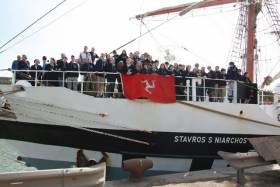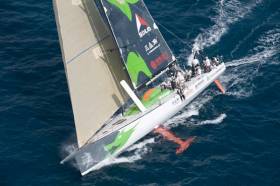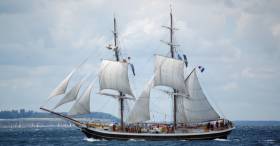Displaying items by tag: Tall Ships
#SupportSailStudents - An initiative which will see young students from the Isle of Man embark on a potentially life-changing adventure on board a tallship begins this month.
The initiative is once again been supported by the Isle of Man Steam Packet Company with the cost of travel to and from Liverpool for the 40 students and eight adults who will accompany them.
Manx charity The Children’s Centre is coordinating a trip which will see 40 youngsters help crew Stavros S Niarchos, a 60 metre-long square-rigged brig ship. The week-long experience, which begins in Liverpool, is run by The Tall Ship Youth Trust. The Trust works to improve the self-esteem and confidence of young people aged 12 to 25 and encourages more active lifestyles, values similar to the aims of The Children’s Centre.
During the trip the Year 9 students from secondary schools across the Isle of Man will learn valuable life and citizenship skill, as well as enjoying the experience of sailing on a spectacular tall ship, travelling wherever the wind takes them.
Adventure Events Fundraising Coordinator at The Children’s Centre Mark Eastham said: ‘At The Children’s Centre we appreciate and understand the immense value of off-Island trips such as the Tall Ship Voyage, and have seen the life-changing impact such experiences can have on young people.
‘Although the challenge is very demanding, it teaches the children the importance of team-building and self-confidence and is a fantastic way for these students to develop skills in a practical and exciting way.
‘The Steam Packet Company has been an active supporter of The Children’s Centre for many years, and we are very grateful it has agreed to assist with the travel costs for this trip once again. It is important such experiences are affordable, which makes this support so valuable in giving as many young people as possible access to opportunities like the Tall Ship Voyage.’
The company's Chief Executive Mark Woodward said: ‘It is always a pleasure to help organisations like The Children’s Centre when we can, as they do such important work in the Isle of Man.
Woodward added ‘It is particularly fitting as a shipping company with a long and proud history that the Steam Packet Company is able to support these students as they experience life on a tall ship, and learn the value of teamwork and self-confidence that such a voyage will teach them.’
Jamie Boag Honoured At Atlantic Youth Trust Gala
#JamieBoag - Volvo Ocean Race team commercial boss Jamie Boag was honoured for his contributions to sailing at the Atlantic Youth Trust's conference and dinner in Galway last weekend, as the Galway Independent reports.
The commercial director of Abu Dhabi Ocean Racing – winners of the most recent Volvo Ocean Race – received the trust's Lifetime Achievement Award for his work with its Irish-flavoured predecessor Green Dragon Racing, as well as his hand in bringing the world's most gruelling ocean yacht race to Galway.
Also on the evening last Saturday (12 March), the Galway Independent contributed €5,000 towards a seed fund to develop a bursary for youth sail trainees in the West of Ireland, along the lines of those already established in Drogheda and West Cork.
The day's conference also saw discussions and workshops on the trust's plans to build a new tall ship for Ireland, as previously reported on Afloat.ie.
Tall Ship Sailing Chance Between Irish & Scottish Ports
Anyone aged between 16 and 28 who would like to sail aboard a Tall Ship is being offered the opportunity by Belfast City Council and Sail Training Ireland. As Afloat.ie previously reported, The Tall Ships, “Maybe” and “Morgenster” are the vessels on which voyages between Belfast, Scottish and Irish ports, will be available, as part of Belfast’s Maritime Festival. Applications are invited with a deadline of Friday, March 25.
More Info On Next Month's Atlantic Youth Trust Conference
#TallShips - The Atlantic Youth Trust has revealed more details of its inaugural conference and gala dinner in Galway next month, as previously reported on Afloat.ie.
Designed as workshops with input from participants, the day's programme comprises three lively sessions commencing at 11.30am with a break for lunch and the Six Nations rugby match, and rolling into the evening's gala ball.
Session 1 is on 'Educating & Youth Development on the Ocean', a concept something obvious to those who have experienced it first hand yet hard to comprehend for those that haven't. The conference will hear from some of the island's most experience shore-based and ocean-based educators.
Session 2 from 3/30pm is on 'Vessel Design & Construction' - with an emphasis on how to design the best yacht or tall ship to be fit for purpose.
While the focus will be on the Atlantic Youth Trust's proposed new tall ship, the session will hear from a range of experts in traditional and modern design, and will also explore the Galway Hooker One Design concept.
Session 3 from 4.30pm is on the topic 'SeaFest 2016 & Hosting and Attracting Major Maritime Events'. Speakers will include some of the most experienced event managers of high-profile maritime events on the island of Ireland previewing SeaFest 2016 this July and discussing the development of related ideas informed by last year's inaugural event.
The day's events are aimed to attract a wide range of stakeholders and will conclude with the gala dinner.
To book your free place at the conference (lunch not provided) or to book a table or individual place at the dinner, visit the Atlantic Youth Trust website HERE. Special hotel rates are also available.
Atlantic Youth Trust Hosting Inaugural Gala In March
#TallShips - The Atlantic Youth Trust is set to host its inaugural conference and gala ball in Galway this March, as the Galway Independent reports.
The sail training tall ship project, which recently hailed its inclusion in the new implementation plan for the Stormont Agreement, will hold the event at the Galway Bay Hotel on Saturday 12 March – in the same city that's prepping a bid to attract the Tall Ships Races in 2019.
Besides hosting an evening of keynote speakers and an afternoon of workshops, the day is also intended to double as a fundraiser for a West of Ireland Bursary Fund for youth sail training along the lines of those already established in Drogheda and West Cork.
As previously reported on Afloat.ie, the Atlantic Youth Trust proposes the construction of a new tall ship to replace the Asgard II as a symbol of cross-border unity and a practical training vessel to teach adaptable skills for young people.
The Galway Independent has much more on the story HERE.
Sail Training Opportunities In 2016
#TallShips - Sail Training Ireland has announced details of its tall ships voyages for youth sailors in 2016.
Three voyages are scheduled on board the 46m brig Morgenster in May and June – Cork to the Netherlands for under-18s (calling at Waterford and Wales), Belfast to Cork for over-18s (calling at the Isle of Man and Dublin) and an open delivery voyage from the Netherlands to Belfast.
Smaller crews will be welcomed on board the Dutch ketch Maybe for a series of 11-day voyages from April to June under the Leargas Youth Exchange programme for under-18, taking in Oban in Scotland, Belfast, Galway, Dublin and ports between.
In addition, the two established bursary schemes for young people in Ireland will hold their own voyages this summer, with the Drogheda Bursary Scheme scheduling two short adventure sailing trips on board the Spirit of Oysterhaven (Waterford–Drogheda and Drogheda–Derry), and the Cork Bursary Scheme sending participants on the same 70ft classic schooner around the South West.
During these five-day excursions young people will learn about the maritime environment, develop their sailing skills and challenge themselves both physically and mentally.
In addition, the 70ft ketch Brian Boru will embark on five discovery voyages for under-18s and over-18s between Waterford, Dublin and Drogheda beginning in March.
Places on these voyages are limited and expensive, but come part-funded thanks to local and European bursary schemes, individuals and sponsoring organisations, topped up by donations raised by each trainee.
Sail Training Ireland has more on its 2016 sailing training voyages HERE.
Ocean Youth Trust South Wins Sail Training Vessel of the Year Award
John Laing, the sailing vessel operated by Hampshire-based charity Ocean Youth Trust South has been announced as the Sail Training Vessel of the Year by the Maritime and Coastguard Agency (MCA) and the Association of Sail Training Organisations (ASTO).
John Laing is used to offer personal development through adventure under sail to young people aged 12-25, building confidence, team working and the ability to take responsibility and cope with unfamiliar experiences.
The trophy was presented by Sir Alan Massey KCB, the Chief Executive of the MCA, who said: "John Laing receives the award today in recognition of 25 years of outstanding service to sail training, reflecting also the great care that Ocean Youth Trust South has taken over the years in ensuring the highest standards of safety and quality in what they do for sail training."
Mark Todd, Chief Executive of OYT South, said: "We are enormously proud to have received this award and it is a huge tribute to the work of all our volunteers, sponsors, donors and staff. Our sail training vessel John Laing has spent 25 years offering voyages to thousands of young people from all backgrounds - some of them very disadvantaged or vulnerable. The boat completed a voyage around the world in 1995-7 with young people as crew, and has since spent numerous seasons based in the Solent. It's wonderful that John Laing has achieved such recognition as she nears the end of her time with the charity and we move on to our new boat Prolific
The future for OYT South is very exciting and we look forward to offering safe, high-quality and fun voyages to thousands more young people in the years to come."
#TallShips - Sail Training Ireland will host its 2016 Annual Awards and season launch at Dublin's Mansion House on Saturday 23 January, it has been announced.
Lord Mayor of Dublin Críona Ní Dhálaigh will join many of the young people who took part in voyages on tall ships and other sail training vessels throughout 2015 in attendance at the special event from 2-4pm.
Sail Training Ireland ran its fifth, sixth and seventh projects under the Erasmus+ scheme for education and sport during 2015, two of them 'youth exchange' project plus a 'mobility for youth workers' project comprising 67 participants in total, and with a focus on employability.
Last year was also the third year of the successful Drogheda Sail Training Bursary Scheme, as previously detailed on Afloat.ie, and information will be available on a number of local bursary schemes now in place or under development, including in Cork, Dublin, Waterford, Wexford and Limerick – as well as a new link between Dublin and Liverpool under their intentional twin cities strategies and being developed as part of their respective river festivals.
Organisations that work with young people are welcome to attend and avail of the opportunity to become a 'nominating organisation' and send youths to take part in future funded voyages.
Sail Training Ireland aims to fund 350 trainee voyage berths in 2016 accessible to young people between the ages of 16 and 30, with a special emphasis on those with disabilities.
Funding has also been received from the Department of Children and Youth Affairs to develop a sail training initiative in partnership with An Garda Síochána for young people at risk of offending who are involved in the current Garda Diversion Projects.
Places on the day are limited so please contact [email protected] for details.
Galway Prepping Bid For Tall Ships Races In 2019
#TallShips - Galway could join the running to host the Tall Ships Races in 2019, as the Connacht Tribune reports.
City councillor and former Galway mayor Padraig Conneely is spearheading efforts to attract the tall ships to Galway Harbour – and the potential €50 million boost to the economy they'd bring with them.
Preliminary discussions have already taken place to explore the viability of a bid for the annual sailing spectacle in light of Dublin's opting out of the running for 2019.
“Galway has a great track record in hosting maritime events and the city has proven itself to be a great host for such events," said Cllr Conneely, citing the Volvo Ocean Race finale in 2012 and the stopover in 2009.
The Connacht Tribune has more on the story HERE.
Sail Training Tall Ship Project Included In Stormont Agreement Plans
#TallShips - The Atlantic Youth Trust has hailed its inclusion in the new implementation plan for the Stormont Agreement announced yesterday.
As RTÉ News reports, Northern Ireland's power-sharing administration finally struck a deal yesterday (Tuesday 17 November) after more than two months of negotiations.
And according to the trust's Neil O'Hagan, the sail training initiative is "the only the only independent charitable project included in both this agreement and the Irish Government's Capital Investment Plan.
"This secures our future and most importantly our ability to deliver youth development, peace-building and maritime education voyages for generations to come. In the coming weeks we will be working with both administrations to determine timelines," he added.
The Atlantic Youth Trust has proposed the construction of a new tall ship as a replacement for the Asgard II to bring young people from both sides of the border together for sail training voyages.
O'Hagan said the inclusion of the project "in a historic document such as this does not come easily and would not be possible without the support and guidance of our stakeholders.
"We would like to once again thank everyone involved in getting us to this point and look forward to working with you all over the coming years."
































































